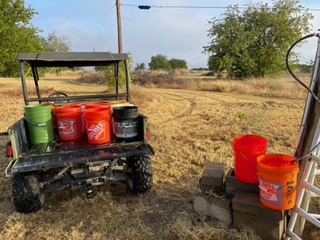Our trusty Cub Cadet UTV is coming in handy this week for hauling 5-gallon water buckets to the animals’ stock tanks. One of the pump houses operated by our local water cooperative failed Tuesday night. A bad pump needs to be replaced. That leaves a small pump at a separate well house that is still working, but there is not enough water pressure to push the water up to the house and barns. Fortunately, with the hydrant we installed at a low-lying place on the property, we are able to coax out water at a bout a gallon a minute to fill buckets. It takes about five minutes then to fill a five gallon bucket. A gallon of water weighs 8.34 pounds. So the UTV is hauling just over 400 pounds when we fill up ten buckets. Of course, we use plastic lids so the water does’t slosh out.
Just to “top off” the stock tanks so the sheep, goats, donkeys, etc. can drink, we need about 50 gallons of water – twice a day. That means including evaporation and waste, they typically consume about 100 gallons per day. Over the past three days, this has taken several hours each day to fill, haul, and dump out all of this water. That’s clearly not sustainable, but we are assured things will be fixed and back to normal by tonight. Wednesday morning we used the pickup truck to go the the Lofers Bend boat ramp (Lake Whitney) and dip water out from a pier jutting into the water. I reckon the five dollar boat ramp fee was worth it even though I wasn’t launching any watercraft. A few hours later, the small pump house was up and running so we did not have to leave the property to haul water after that.
Unfortunately for us, we are at the “end of the line” of the water distribution pipes. That means we get the least amount of water pressure. And when something goes wrong, we feel it first… The water meters themselves are approximately one mile away from the house, located off of a spur that joins the main property to a county road. We are responsible for maintaining all of the underground water distribution pipes from the meters at the county road. It’s about two and a half miles of pipe since there are two meters, and we’ve run new lines over to the barns a few years ago.
You may wonder, where does this water come from? We are in the Middle Trinity Groundwater Conservation District. The water source here is primarily the Trinity Aquifer. Water is held amidst consolidated rock including both granite and limestone formations of the hill country of Central Texas and the Edwards Aquifer. Some wells are deep, at about 600 feet and others are more “surface” wells or sometimes called ground water wells. Our water coop is small, with a few part-time employees and a board of trustees who are neighbors. The coop serves 235 water meters, and since we have two of them on our property, we reckon quite a few other ranches have more than one meter. We guess there are about 175 member families in all.
“Dig your own well, then.” Sure, we’ve thought of that. In fact we have a defunct well that came with the property. It does not work and it only goes down 300 feet which is OK for irrigation, but we are told it has to go down 600 feet for suitable drinking water based on our location. We’ve been quoted anywhere between 50 and 85 thousand dollars to deploy a new well or re-drill and old one and outfit it with a new pump. We are not sure that’s worth it so long as these breakdowns do not continue. We will see…

